Title Page
-
Site conducted
-
Conducted on
-
Work to commence on
-
Prepared by
-
Location
-
Site contact
-
Order number
-
Machine manufacturer and model
-
Serial number
Method statement
-
Follow the below for general rules when working in factories and on machinery -
• Engineer must where oil resistant, anti-slip safety footwear at all all times.
• Engineer must wear gloves wherever possible to prevent injuries and exposure to chemicals.
• Engineer must wear glasses in tasks where material can be ejected.
• Engineer must always wear knee pads when working.
• Engineer must observe and adhere to site rules where he/ she is working unless it places them in danger.
• Engineer must gain approval from site contact to start works.
• Engineer must let all persons in area know they are working in the area and what they are doing prior to task beginning.
• Engineer must be aware of the machinery they are working on and the dangers it poses.
• Engineer must work with operator if possible, as to avoid unnecessary incidents and further damage.
• Do not climb on top of the machine unless working at height safety controls are in place.
• If the customer has defeated the safety systems and wishes the machine to be returned in an unsafe state, this must be indicated on the report and advised against. The machine is the customers property and therefore their responsibility.
• Machines must never be left in an unsafe state. They must be locked of electrically overnight if still being worked on and all guards, panels and general housekeeping must be safe for people to be working around. -
Please ensure the customer has carried out their responsibilities prior to the job starting -
• The customer must alert the engineer to all dangers and risks posed on site related to their works.
• If the customer has defeated the safety systems and wishes the machine to be returned in an unsafe state, this must be indicated on the report and advised against. The machine is the customers property and therefore their responsibility.
• The customer is responsible for providing information on what they are machining (metals, plastics etc.), what coolants they are using, what chemicals are stored on site and anything else that may pose a danger to the engineer involved.
• The customer is responsible for providing oils, chemicals and spill kits.
• The more the customer assists the engineer with the task the faster and more safely it will be completed. -
To be carried out in no particular order:
1. Using Hand Tools (e.g., spanners and screwdrivers):
Objective: To ensure safe and efficient use of hand tools in machine tool maintenance.
Method Statement:
• Personal Protective Equipment (PPE): Wear appropriate PPE, including safety gloves and eye protection.
• Tool Inspection: Inspect hand tools before use to ensure they are in good condition.
• LOTO Procedure: Apply Lockout/Tagout procedures to isolate and secure the machine before using hand tools.
• Workspace Preparation: Clear the workspace of any unnecessary items and ensure proper lighting.
• Housekeeping: Maintain a clean and organized workspace, promptly removing any debris or waste.
• Tool Selection: Choose the correct hand tool for the specific task at hand.
• Proper Technique: Use the tools with proper technique to avoid strain or injury.
• Secure Workspace: Ensure the machine is powered off and properly secured before using hand tools.
• Tool Maintenance: Clean and maintain tools regularly to ensure optimal performance.
2. Lifting Items Off Machines Safely Using Rigging Methods:
Objective: To safely lift and move items from machines during maintenance.
Method Statement:
• Risk Assessment: Assess the weight and dimensions of the item to be lifted.
• LOTO Procedure: Apply Lockout/Tagout procedures to isolate and secure the machine before lifting.
• Use of Rigging Equipment: Select appropriate rigging equipment such as slings, shackles, and hoists.
• Secure Load: Ensure the load is properly secured and balanced before lifting.
• Communication: Establish clear communication signals between the maintenance technician and any assisting personnel.
• Safe Lifting: Lift the item smoothly and steadily, avoiding sudden movements.
• Clear Pathways: Ensure pathways are clear to avoid obstructions during the lifting process.
• Teamwork: If necessary, coordinate with a team to ensure the safe lifting and movement of heavy items.
3. Using a Multimeter While Live Working:
Objective: To safely use a multimeter for diagnostics while the machine is live.
Method Statement:
• Safety Procedures: Ensure all necessary safety procedures are in place, and wear appropriate PPE.
• LOTO Procedure: Apply Lockout/Tagout procedures to isolate and secure the specific component or circuit being tested if possible.
• Multimeter Inspection: Check the multimeter for any visible damage and ensure proper functioning.
• Proper Settings: Set the multimeter to the appropriate range and function for the measurement.
• Stable Positioning: Keep the multimeter in a stable position to prevent accidental slips.
• One-Hand Rule: Whenever possible, use the "one-hand rule" to minimize the risk of electric shock.
• Regular Checks: Periodically check the multimeter leads for wear and tear.
4. Manual Handling:
Objective: To safely handle and move objects manually during maintenance tasks.
Method Statement:
• LOTO Procedure: Apply Lockout/Tagout procedures before attempting manual handling to ensure the machine is safely isolated.
• Team Communication: Establish clear communication between team members during manual handling tasks.
• Assessment: Assess the weight and size of the load before attempting manual handling.
• Lifting Technique: Use proper lifting techniques, including bending the knees and keeping the back straight.
• Team Lifts: When handling heavy loads, involve a team to share the load.
• Rest Breaks: Take regular breaks to prevent fatigue during prolonged manual handling tasks.
5. Storing and Organizing Parts:
Objective: To organize and store machine parts efficiently during maintenance.
Method Statement:
• Identification: Clearly label and identify each part for easy retrieval.
• LOTO Procedure: Apply Lockout/Tagout procedures before removing and storing parts to ensure machine isolation.
• Storage Area: Designate a specific storage area for machine parts.
• Organization System: Implement an organized system, such as categorizing parts by type or function.
• Inventory Management: Keep a detailed inventory of stored parts to track availability.
• Protective Measures: Store sensitive or fragile parts in protective containers to prevent damage.
• Accessibility: Ensure easy accessibility to stored parts for efficient reassembly.
6. Working with Chemicals:
Objective: To safely handle and use chemicals during maintenance tasks.
Method Statement:
• Material Safety Data Sheets (MSDS): Review MSDS for each chemical to understand hazards and safe handling procedures.
• PPE: Wear appropriate PPE, including gloves and eye protection, when handling chemicals.
• Ventilation: Ensure proper ventilation in the workspace when using chemicals.
• LOTO Procedure: Apply Lockout/Tagout procedures if chemicals are associated with specific machine systems.
• Spill Response: Have spill response kits readily available, and know the proper procedures for handling spills.
• Storage: Store chemicals in designated areas, following recommended guidelines.
• Labeling: Clearly label all chemical containers with product names and hazard warnings.
• Training: Ensure that personnel are trained in the safe handling of specific chemicals.
• Housekeeping: Keep the work area clean, promptly disposing of any waste generated during chemical handling.
• Segregating Waste: Segregate waste materials, disposing of them in designated bins for recycling or appropriate disposal.
7. Working on Systems with Stored Energy (e.g., hydraulic & pneumatic):
Objective: To safely work on machine systems with stored energy.
Method Statement:
• LOTO Procedure: Apply Lockout/Tagout procedures to isolate and secure energy sources before starting any maintenance work. Ensure pressures on dials are at zero.
• Verification: Confirm that the system is depressurized and energy-free before commencing work.
• PPE: Wear appropriate gloves, glasses and overalls.
8. Strpping cables
• For safety reasons, please refrain from using Stanley knives to strip cables. Utilising specialised cable stripping tools designed for the task ensures not only efficiency but also minimises the risk of injury and damage to the cable insulation. Prioritise your safety and the integrity of the wiring by using the appropriate tools for cable stripping.
Amendments page
-
Please use the following section to make site specific amendments for any unforseen changes to the above methods
Risk matrix
-
Assessed by
-
Date
Hazard
-
Description of hazard
-
Risk related to hazard
-
Who might be harmed?
-
Risk likelihood
-
Risk consequences
-
Use this risk matrix to identify the risk level:
-
Probability and severity
-
Risk level
-
Hazard causing risk can be eliminated?
-
Are you already doing something to control this risk (existing risk control measure)?
-
Briefly describe the existing control measure:
-
Briefly describe the existing control measure:
-
Further action needed to control the risk?
-
Select the "Action" icon to create an action, assign it to someone, and set a due date.
-
Eliminate the hazard causing the risk.
-
Are you already doing something to control this risk (existing risk control measure)?
-
Briefly describe the existing control measure:
-
Further action needed to control the risk?
-
Select the "Action" icon to create an action, assign it to someone, and set a due date.
-
Monitor this risk.
-
Hazard causing risk can be eliminated?
-
Eliminate the hazard causing the risk.
-
Briefly describe the control measure
-
Hazard causing risk can be eliminated?
-
Briefly describe the control measure
-
Eliminate the hazard causing the risk.
-
Hazard causing risk can be eliminated?
-
Briefly describe the control measure
-
Eliminate the hazard causing the risk.
-
Resulting probabilty and severity
-
Resulting risk level
-
To ADD another hazard to the workplace risk assessment, select the "+" icon next to Hazard.
To END the workplace risk assessment, select the "Next Page >" button at the bottom right.












